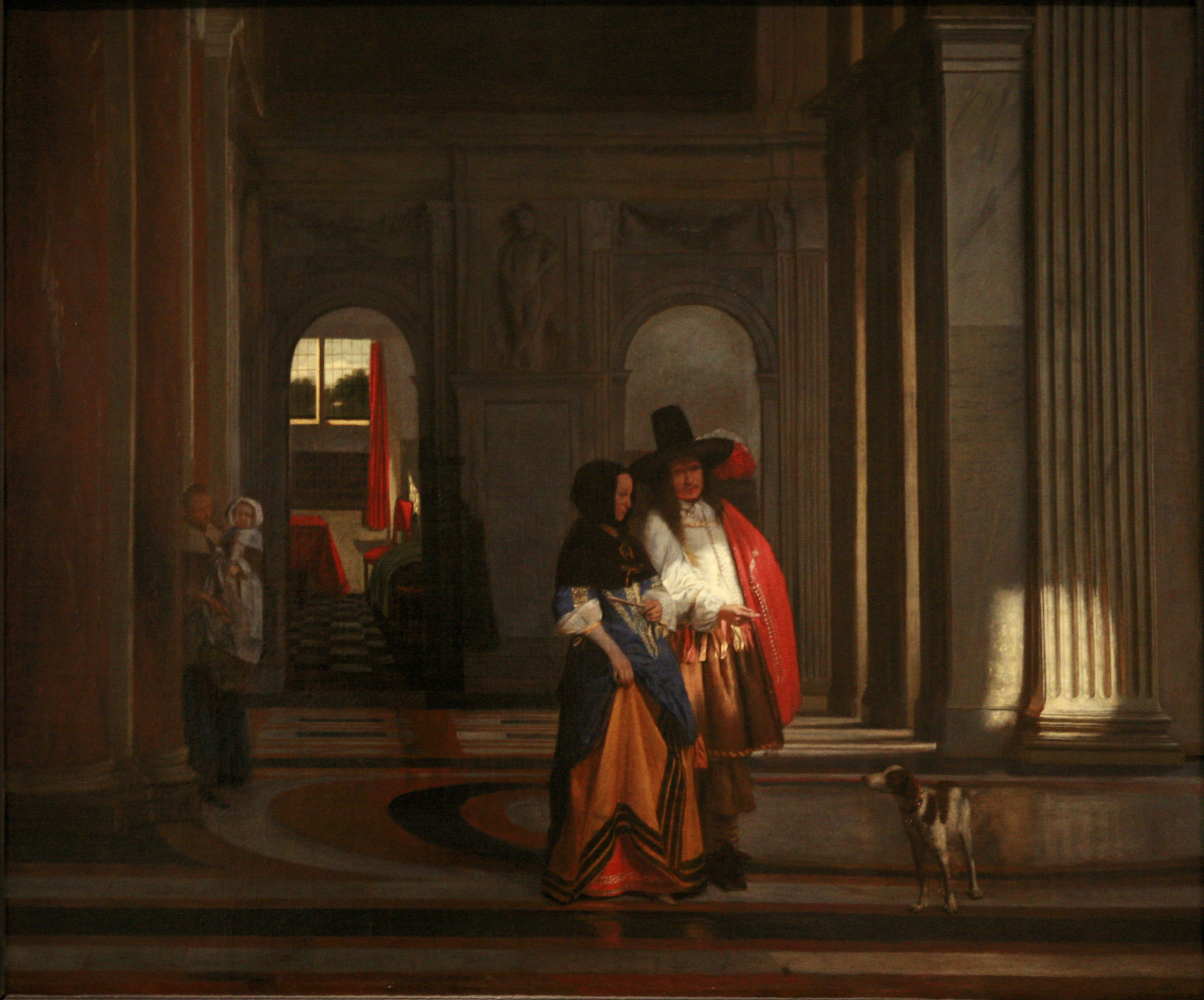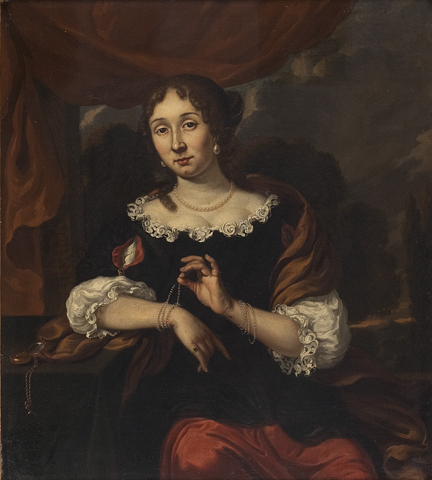|
Eglon Van Der Neer
Eglon van der Neer (1635/363 May 1703) was a Dutch painter of historical scenes, portraits and elegant, fashionable people, and later of landscapes. Life Van der Neer was born in Amsterdam and was probably first taught by his father, Aert van der Neer, who married in Amsterdam in 1629, coming from Gorinchem. Eglon had a least five brothers and sisters, who were baptized in the Nieuwe Kerk between 1640 and 1650. He took lessons from Jacob van Loo, who was then one of the foremost figure painters in Amsterdam. Around 1654, Van der Neer, who probably had just finished his education with van Loo, traveled to Orange, Vaucluse in the south of France and entered the service of Friedrich von Dohna (1621–1688), governor of the Principality of Orange. Van der Neer stayed for three or four years in Orange and returned to Amsterdam by the end of 1658. There he married (in February) Maria Wagensvelt, the daughter of a wealthy Rotterdam notary. In 1663, van der Neer and his family m ... [...More Info...] [...Related Items...] OR: [Wikipedia] [Google] [Baidu] |
Marie Du Chastel
Marie Duchatel or Marie Du Chastel (1652 – 1692) was a Flemish painter and miniaturist. She had an international career which brought her to work at the courts of Denmark and East Frisia. She married the Dutch painter Eglon van der Neer with him she also travelled abroad. She is mainly known for her portraits.Marie Duchatel at the Life She was born in Brussels where she was baptized on 20 November 1652. She was the daughter of the Flemish painter ...[...More Info...] [...Related Items...] OR: [Wikipedia] [Google] [Baidu] |
Adam Elsheimer
__NOTOC__ Adam Elsheimer (18 March 1578 – 11 December 1610) was a German artist working in Rome, who died at only thirty-two, but was very influential in the early 17th century in the field of Baroque paintings. His relatively few paintings were small scale, nearly all painted on copper plates, of the type often known as cabinet paintings. They include a variety of light effects, and an innovative treatment of landscape. He was an influence on many other artists, including Rembrandt and Peter Paul Rubens. Life and work Elsheimer was born in Frankfurt am Main, one of ten children and the son of a master-tailor. His father's house (which survived until destroyed by Allied bombs in 1944) was a few metres from the church where Albrecht Dürer's ''Heller Altarpiece'' was then displayed. He was apprenticed to the artist Philipp Uffenbach. He probably visited Strasbourg in 1596. At the age of twenty, he travelled to Italy via Munich, where he was documented in 1598. His ... [...More Info...] [...Related Items...] OR: [Wikipedia] [Google] [Baidu] |
Frans Van Mieris The Elder
Frans van Mieris the Elder (16 April 163512 March 1681), was a Dutch Golden Age genre and portrait painter. The leading member of a Leiden family of painters, his sons Jan (1660–1690) and Willem (1662–1747) and his grandson Frans van Mieris the Younger (1689–1763) were also accomplished genre painters. Biography Frans was born and died in Leiden, where his father Jan Bastiaans van Mieris was a goldsmith, carver of rubies and diamond setter. [Baidu] |
Gabriel Metsu
In Abrahamic religions (Judaism, Christianity and Islam), Gabriel (); Greek: grc, Γαβριήλ, translit=Gabriḗl, label=none; Latin: ''Gabriel''; Coptic: cop, Ⲅⲁⲃⲣⲓⲏⲗ, translit=Gabriêl, label=none; Amharic: am, ገብርኤል, translit=Gabrəʾel, label=none; arc, ܓ݁ܰܒ݂ܪܺܝܐܝܶܠ, translit=Gaḇrīʾēl; ar, جِبْرِيل, Jibrīl, also ar, جبرائيل, Jibrāʾīl or ''Jabrāʾīl'', group="N" is an archangel with power to announce God's will to men. He is mentioned in the Hebrew Bible, the New Testament, and the Quran. Many Christian traditions — including Anglicanism, Eastern Orthodoxy, and Roman Catholicism — revere Gabriel as a saint. In the Hebrew Bible, Gabriel appears to the prophet Daniel to explain his visions (Daniel 8:15–26, 9:21–27). The archangel also appears in the Book of Enoch and other ancient Jewish writings not preserved in Hebrew. Alongside the archangel Michael, Gabriel is described as the guardian angel of ... [...More Info...] [...Related Items...] OR: [Wikipedia] [Google] [Baidu] |
Gerard Ter Borch
Gerard ter Borch (; December 1617 – 8 December 1681), also known as Gerard Terburg (), was a Dutch genre painter who lived in the Dutch Golden Age. He influenced fellow Dutch painters Gabriel Metsu, Gerrit Dou, Eglon van der Neer and Johannes Vermeer. According to Arthur K. Wheelock Jr., Ter Borch "established a new framework for subject matter, taking people into the sanctum of the home", showing the figures' uncertainties and expertly hinting at their inner lives. His influence as a painter, however, was later surpassed by Vermeer. Biography Gerard ter Borch was born in December 1617 in Zwolle in the province of Overijssel in the Dutch Republic. He received an excellent education from his father Gerard ter Borch the Elder, also an artist, and developed his talent very early. The inscription on a study of a head proves that Ter Borch was at Amsterdam in 1632, where he studied possibly under Willem Cornelisz Duyster or Pieter Codde. Duyster's influence can be traced in a pic ... [...More Info...] [...Related Items...] OR: [Wikipedia] [Google] [Baidu] |
Pieter De Hooch
Pieter de Hooch (, also spelled "Hoogh" or "Hooghe"; 20 December 1629 (baptized) – 24 March 1684 (buried)) was a Dutch Golden Age painter famous for his genre works of quiet domestic scenes with an open doorway. He was a contemporary of Jan Vermeer in the Delft Guild of St. Luke, with whom his work shares themes and style. Biography De Hooch was born in Rotterdam to Hendrick Hendricksz de Hooch, a bricklayer, and Annetge Pieters, a midwife. He was the eldest of five children and outlived all of his siblings. Little is known of his early life and most archival evidence suggests he worked in Rotterdam, Delft, and Amsterdam. According to his first biographer Arnold Houbraken, he studied art in Haarlem under the landscape painter Nicolaes Berchem at the same time as Jacob Ochtervelt and was known for his "kamergezichten" or "room-views" with ladies and gentlemen in conversation. [...More Info...] [...Related Items...] OR: [Wikipedia] [Google] [Baidu] |
Düsseldorf
Düsseldorf ( , , ; often in English sources; Low Franconian and Ripuarian: ''Düsseldörp'' ; archaic nl, Dusseldorp ) is the capital city of North Rhine-Westphalia, the most populous state of Germany. It is the second-largest city in the state and the seventh-largest city in Germany, with a population of 617,280. Düsseldorf is located at the confluence of two rivers: the Rhine and the Düssel, a small tributary. The ''-dorf'' suffix means "village" in German (English cognate: ''thorp''); its use is unusual for a settlement as large as Düsseldorf. Most of the city lies on the right bank of the Rhine. Düsseldorf lies in the centre of both the Rhine-Ruhr and the Rhineland Metropolitan Region. It neighbours the Cologne Bonn Region to the south and the Ruhr to the north. It is the largest city in the German Low Franconian dialect area (closely related to Dutch). Mercer's 2012 Quality of Living survey ranked Düsseldorf the sixth most livable city in the world. Düsse ... [...More Info...] [...Related Items...] OR: [Wikipedia] [Google] [Baidu] |
Adriana Spilberg
Adriana Spilberg (1652, Amsterdam – 1700, Düsseldorf), was a Dutch Golden Age painter active at the court of Johann Wilhelm, Elector Palatine.(Germancourt painters who worked at the court of Johan Wilhelm, according to the Dusseldorf museum website and Museum Kunstpalast Biography According to Houbraken her father Johannes Spilberg taught her to paint in oils, crayon and pastels and she became quite famous in Amsterdam.Adriana Spilberg Biography in ''De groote schouburgh der Nederlantsche konstschilders en schilderessen'' (1718) by , courtesy of the |
Johannes Spilberg
Johannes Spilberg (30 April 1619 – 10 August 1690) was a German Baroque painter, active in Amsterdam during the period known as the Dutch Golden Age. Life Spilberg was born and died in Düsseldorf.Johannes Spilberg (II) in the He learned to paint from his father, who painted in oils and on glass, who then sent him to , to learn under . [...More Info...] [...Related Items...] OR: [Wikipedia] [Google] [Baidu] |
Johann Wilhelm, Elector Palatine
Johann Wilhelm II, Elector Palatine (''"Jan Wellem"'' in Low German, English: ''"John William"''; 19 April 1658 – 8 June 1716) of the Wittelsbach dynasty was Elector Palatine (1690–1716), Duke of Palatinate-Neuburg, Neuburg (1690–1716), Duchy of Jülich, Duke of Jülich and Berg (German region), Berg (1679–1716), and Duke of Upper Palatinate and Cham (1707–1714). From 1697 onwards Johann Wilhelm was also Count of Megen. Early life and background He was the son of Philipp Wilhelm, Elector Palatine, Count Palatine Philip William of Neuburg and Elisabeth Amalie of Hesse-Darmstadt and was born in Düsseldorf, where he resided, rather than in Heidelberg#Modern history, Heidelberg, which had been largely destroyed by French troops during the Nine Years' War. He was educated by the Jesuits and in 1674 he made a grand tour to Italy. His brother was Franz Ludwig von Pfalz-Neuburg, Franz Ludwig, Count Palatine of Neuburg, his sisters were married to Leopold I, Holy Roman Em ... [...More Info...] [...Related Items...] OR: [Wikipedia] [Google] [Baidu] |

_-_A_lady_called_Anna_Maria_Louisa_de'_Medici.jpg)
_-_The_Music_Lesson_-_WGA15633.jpg)
.jpg)
.jpg)



